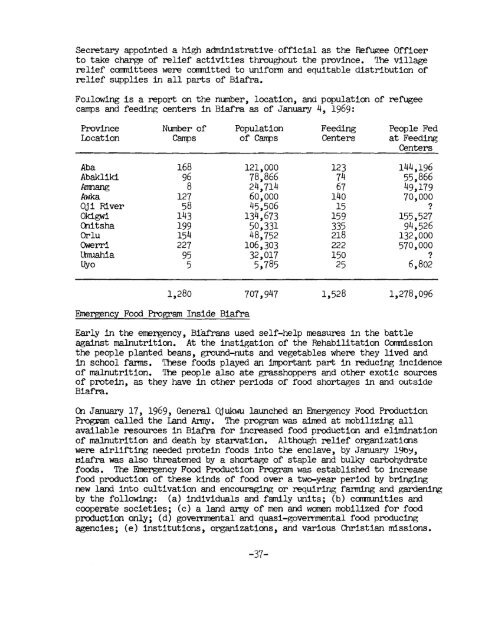3. - usaid
3. - usaid
3. - usaid
You also want an ePaper? Increase the reach of your titles
YUMPU automatically turns print PDFs into web optimized ePapers that Google loves.
Secretary appointed a high administrative-official as the ReruRee Officer<br />
to take charge of relief activities throughout the province. The village<br />
relief comnittees were comnitted to uniform and equitable distribution of<br />
relief supplies in all parts of Biafra,<br />
Following is a report on the number, location, and population of refugee<br />
camps and feeding centers in Biafra as of January 4, 1969:<br />
Province Number of Population Feeding People Fed<br />
beat ion camps of Camps Centers at Feeding<br />
Centers<br />
Aba<br />
Abakliki<br />
Amnang<br />
Awka<br />
0ji River<br />
okigwi<br />
Chitsha<br />
Orlu<br />
Owerri<br />
Umuahia<br />
Vyo<br />
ESnergency Food Program Inside Biafra<br />
Early in the emergency, Bikfrans used self-help measures in the battle<br />
against malnutrition. At the instigation of the Rehabilitation C ~ssion<br />
the people planted beans, ground-nuts and vegetables where they lived and<br />
in school farms, These foods played an important part in reducing incidence<br />
of malnutrition. The people also ate grasshoppers and other exotic sources<br />
of protein, as they have in other periods of food shortages in and outside<br />
Biafra.<br />
QI January 17, 1969, General Ojukwu launched an hergency Food Production<br />
Proppun called the Land Army, The program was aimed at mobilizing all<br />
available resources in Biaf'ra for increased food productim and elimination<br />
of malnutrition and death by starvation, Although relief organizatians<br />
were airlifting needed protein foods into the enclave, by January IfSby,<br />
aiafra was also threatened by a shortage of staple and bulky carbohydrate<br />
foods. The Ehergency Food Production Program was established to increase<br />
food production of these kinds of food over a two-year period by bringing<br />
new land into cultivation and encouraging or requiring farming and gardening<br />
by the following: (a) individuals and family units; (b) cammities and<br />
cooperate societies; (c) a land anrly of men and women mobilized for food<br />
production only; ( d) governmental' and quasi-govenunental food producing<br />
agencies; (e) institutions, organizations, and various Christian missions.
















